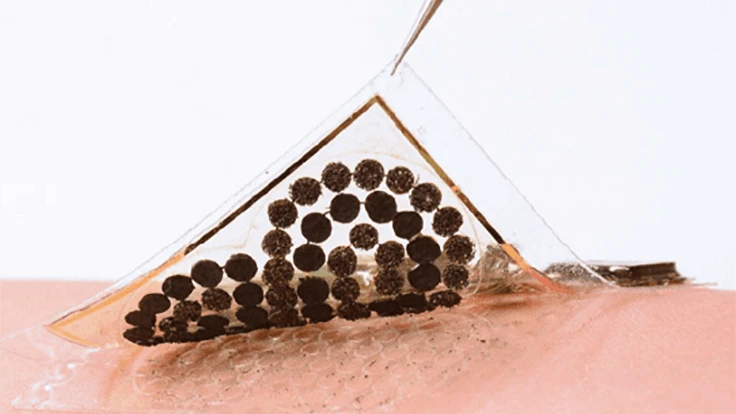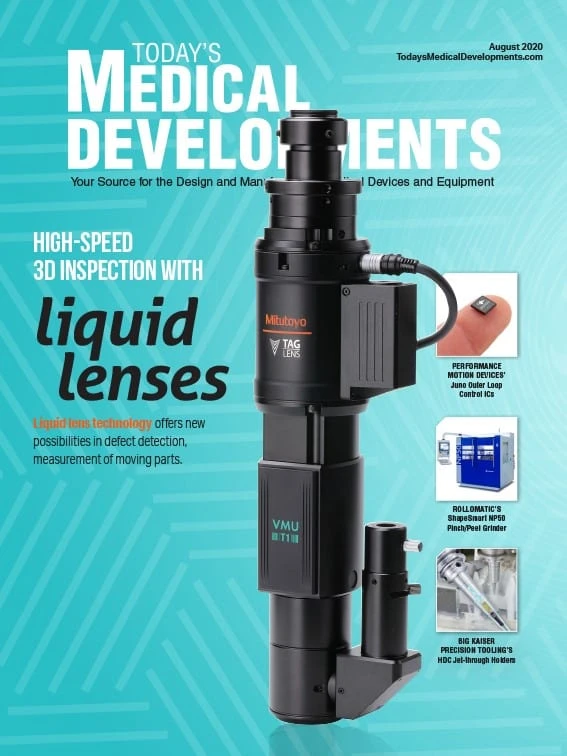
PHOTO COURTESEY OF CALTECH

We experience the world through our skin. From sensing temperature and pressure to pleasure or pain, the nerve endings in our skin tell us a great deal.
Our skin tells the outside world about us as well. Moms press their hands against their children’s foreheads to see if they have a fever. Someone may see a blush rising on their date’s cheeks during an intimate conversation.
To gather further information from a person’s skin, Caltech’s Wei Gao, assistant professor in the Andrew and Peggy Cherng department of medical engineering, developed an electronic skin (e-skin) that applies directly to real skin. Made from soft, flexible rubber, the e-skin can be embedded with sensors that monitor information such as heart rate, body temperature, levels of blood sugar and metabolic byproducts, and nerve signals that control muscles. It does so without a battery, running solely on biofuel cells powered by one of the body’s waste products – sweat.
“One of the major challenges with these kinds of wearable devices is power,” Gao says. “Many people are using batteries, but that’s not very sustainable. Some people have tried using solar cells or harvesting the power of human motion. We wanted to know, ‘Can we get sufficient energy from sweat to power the wearables?’ And, the answer is yes.”
Human sweat contains high levels of lactate, a by-product of normal metabolic processes, especially by muscles during exercise. Fuel cells built into the e-skin absorb the lactate and combine it with oxygen from the atmosphere, generating water and pyruvate, another by-product of metabolism.
As they operate, the biofuel cells generate enough electricity to power sensors and a Bluetooth device, allowing the e-skin to wirelessly transmit readings.
“While near-field communication is a common approach for many battery-free e-skin systems, it can only be used for power transfer and data readout over a very short distance,” Gao says. “Bluetooth communication consumes higher power but is a more attractive approach with extended connectivity for practical medical and robotic applications.”
Devising a power source that could run on sweat was not the only challenge in creating the e-skin – it also needed to last a long time with high power intensity and minimal degradation. The biofuel cells are made from carbon nanotubes impregnated with a platinum/cobalt catalyst and composite mesh holding an enzyme that breaks down lactate. They can generate continuous, stable power output (as high as several milliwatts per square centimeter) for several days from human sweat.
Gao’s plan is to develop a variety of sensors that can be embedded in the e-skin for multiple purposes.
“We want this system to be a platform,” he says. “In addition to being a wearable biosensor, this can be a human-machine interface. The vital signs and molecular information collected using this platform could be used to design and optimize next-generation prosthetics.”
California Institute of Technology
https://www.caltech.edu

Explore the August 2020 Issue
Check out more from this issue and find your next story to read.
Latest from Today's Medical Developments
- IMTS 2026 runs Sept. 14-19 at McCormick Place in Chicago, Illinois
- Master Bond’s MasterSil 800Med
- ZEISS celebrates 100 years of advancing innovation in the US
- Teleflex sells acute care and urology businesses for $2.03 billion
- HANNOVER MESSE: Where research and manufacturing meet
- What’s next for the design and manufacturing industry in 2026?
- Arcline to sell Medical Manufacturing Technologies to Perimeter Solutions
- Decline in German machine tool orders bottoming out





